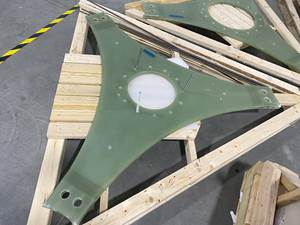European offshore wind headed toward 2016 slowdown?
MAKE Consulting's latest report on global offshore wind power says to expect a capacity expansion slowdown in Europe in 2016, followed by robust growth through 2023.
MAKE Consulting (Aarhus, Denmark) reported on Dec. 19 that it has published a new report on offshore wind energy titled "Global Offshore Wind Power 2014." In it, MAKE says that as the offshore wind industry makes progress to reduce cost of energy in support of an outlook for global average annual growth of 22% to 2023, the European near-term outlook shows a sharp decline of more than 60% in grid-connected offshore wind capacity in 2016 compared to 2015, as the UK nears transition in subsidy schemes and as German project installations peak at close to 2 GW in 2015. Impact to the supply chain is expected to be softened by strong 2017 demand.
MAKE says the global offshore wind market has grown an average more than 30% annually in the last five years, bringing expected global grid-connected capacity to more than 9 GW at the end of 2014 — equivalent to 2.7% of global wind power capacity. In 2014, 2.3 GW of offshore wind capacity will be grid-connected, with Europe accounting for close to 80% of total market size.
Despite declining activity in the UK in 2015, MAKE says next year is set to be another record year for the offshore wind industry, based on peaking German project installations and the Chinese offshore wind development gaining momentum. Globally, MAKE expects 51% growth in 2015. Sustained growth in Asia-Pacific, however, is not able to balance the sharp decline in new grid-connected capacity expected in the UK and Germany in 2016. Depending on market exposure and position in the value chain, impact will vary across the supply chain.
The global offshore wind market is expected to show strong long-term growth rates from 2017, and MAKE expects the market to grow at a 22% CAGR from 2014 to 2023. By 2023, total offshore wind capacity is expected to reach a staggering 82 GW, equivalent to 9.3% of global wind power capacity. By then, says MAKE, APAC will account for 40.4 GW of this capacity and will have caught up with Europe, which will account for 39.4 GW. China will be the main driver for offshore wind growth in APAC, but Japan, South Korea and Taiwan will also make contributions. Annual installed capacity in Europe will vary between 3 GW to 5 GW from 2017 to 2023, supported by national and EU polices. MAKE says clarity on post-2020 regulatory framework is needed for the offshore wind industry to sustain momentum on cost reductions and growth. Smaller scale growth is expected in the Americas with the US accounting for only 2.2 GW of the global expected grid-connected base in 2023.
MAKE expects Levelised-Cost-of-Electricity from offshore wind (LCOE) to be reduced from the current level of €150/MWh to €110/MWh in 2020, slightly above the €100/MWh target set by several major industry players. By 2025, MAKE forecasts LCOE to be reduced to €84/MWh. As such, offshore wind will be making important progress to approaching grid parity.
MAKE says key levers for offshore wind cost reductions include scaling and industrialization of the offshore wind supply chain, technology improvements related to larger turbines and wind plants, lower- cost substructures, higher technical availability and reduced cabling cost, combined with expected reduced cost of capital, lead time and O&M cost.
MAKE’s "Global Offshore Wind Power 2014" is an 88-page report containing more 150 charts, tables and graphs providing in-depth analysis of the global offshore wind power market. Key topics covered include global, regional, and country-specific market assessments, supply-demand trends for turbine assembly, balance of plant and installation, asset ownership trends and project finance trends.
Related Content
Honda begins production of 2025 CR-V e:FCEV with Type 4 hydrogen tanks in U.S.
Model includes new technologies produced at Performance Manufacturing Center (PMC) in Marysville, Ohio, which is part of Honda hydrogen business strategy that includes Class 8 trucks.
Read MoreJEC World 2023 highlights: Recyclable resins, renewable energy solutions, award-winning automotive
CW technical editor Hannah Mason recaps some of the technology on display at JEC World, including natural, bio-based or recyclable materials solutions, innovative automotive and renewable energy components and more.
Read MoreMingYang reveals 18-MW offshore wind turbine model with 140-meter-long blades
The Chinese wind turbine manufacturer surpasses its 16-MW platform, optimizes wind farm construction costs for 1-GW wind farms.
Read MoreRTM, dry braided fabric enable faster, cost-effective manufacture for hydrokinetic turbine components
Switching from prepreg to RTM led to significant time and cost savings for the manufacture of fiberglass struts and complex carbon fiber composite foils that power ORPC’s RivGen systems.
Read MoreRead Next
Plant tour: Daher Shap’in TechCenter and composites production plant, Saint-Aignan-de-Grandlieu, France
Co-located R&D and production advance OOA thermosets, thermoplastics, welding, recycling and digital technologies for faster processing and certification of lighter, more sustainable composites.
Read More“Structured air” TPS safeguards composite structures
Powered by an 85% air/15% pure polyimide aerogel, Blueshift’s novel material system protects structures during transient thermal events from -200°C to beyond 2400°C for rockets, battery boxes and more.
Read MoreAll-recycled, needle-punched nonwoven CFRP slashes carbon footprint of Formula 2 seat
Dallara and Tenowo collaborate to produce a race-ready Formula 2 seat using recycled carbon fiber, reducing CO2 emissions by 97.5% compared to virgin materials.
Read More














.jpg;maxWidth=300;quality=90)









